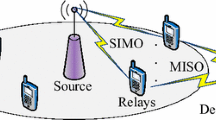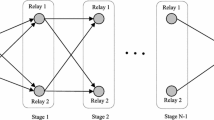Abstract
The throughput performance of cooperative repetition and parallel coding in incremental decode-and-forward is investigated. Four transmission methods are considered: parallel coding with and without distributed space-time coding (PC-ST and PC, respectively); and repetition coding with and without Chase combining at the destination (RC and SC, respectively). The analysis is based on the mutual information seen at the receiver for each scheme. Exact expressions for the outage probability and throughput for all methods are derived. Both ad-hoc and infra-structured relaying scenarios are investigated. Results show that SC can perform very close to RC, PC and PC-ST in terms of throughput, specially in the case of infra-structured relaying or adequate power and rate allocation. The conclusion is that SC would be a better option in practice, since it requires a simpler receiver than PC-ST, PC, and RC.








Similar content being viewed by others
Notes
In SC, as the receiver does not combine the original and the retransmitted messages, the outage is determined by the link with the best SNR between the source to destination and the relay to destination links. Thus, we can say that the receiver applies “selection combining” between the signals received from the source and from the relay.
In this paper all channels are modeled as a random variable from a complex Gaussian distribution with zero mean and unity variance, so that the channel envelope is Rayleigh distributed with unity energy.
The source and the relay retransmit in perfect synchronism only if the relay was able to decode the original source transmission. Otherwise, the retransmission comes from the source alone.
The Matlab function fmincon was used to numerically solve the optimization problem.
One might argue that power allocation between source and relay should not be considered for the infra-structured scenario, since the relay is deployed by the service provider. However, we consider the power allocation between source and relay because in an energy efficiency sense it is interesting to see how well the methods can perform under a limited amount of resources (one could compare the efficiency of ad-hoc relaying to that of infra-structured relaying). Moreover, the general conclusion—that the schemes perform basically the same—simply does not change if one considers only rate allocation in the infra-structured scenario.
References
Goldsmith, A. (2005). Wireless communications (1st edn.). Cambridge: Cambridge University Press.
Laneman, J. N., Tse, D. N. C., & Wornell, G. W. (2004). Cooperative diversity in wireless networks: Efficient protocols and outage behavior. IEEE Transactions on Information Theory, 50(12), 3062–3080.
Nosratinia, A., Hunter, T. E., & Hedayat, A. (2004). Cooperative communication in wireless networks. IEEE Communications Magazine, 42(10), 74–80.
Sendonaris, A., Erkip, E., & Aazhang, B. (2003). User cooperation diversity—Part I: System description. IEEE Transactions on Communications, 51(11), 1927–1938.
Van der Meulen, E. C. (1971). Three-terminal comunication channels. Advanced Applied Probability, 3, 120–154.
Stefanov, A., & Erkip, E. (2004). Cooperative coding for wireless networks. IEEE Transactions on Communications, 52(9), 1470–1476.
Hunter, T. E., Sanayei, S., & Nosratinia, A. (2006). Outage analysis of coded cooperation. IEEE Transactions on Information Theory, 52(2), 375–391.
Zhao, B., & Valenti, M.C. (2003). Distributed turbo coded diversity for relay channel. IEE Electronics Letters, 39(10), 786–787.
Zhang, Z., & Duman, T. M. (2005). Capacity-approaching turbo coding and iterative decoding for relay channels. IEEE Transactions on Communications, 53(11), 1895–1885.
Hu, J., & Duman, T. M. (2007). Low density parity check codes over wireless relay channels. IEEE Transactions on Wireless Communications, 6(9), 3384–3394.
Khormuji, M., & Larsson, E. (2009). Cooperative transmission based on decode-and-forward relaying with partial repetition coding. IEEE Transactions on Wireless Communications, 8(4), 1716–1725.
Laneman, J. N., & Wornell, G. W. (2003). Distributed space-time coded protocols for exploiting cooperative diversity in wireless networks. IEEE Transactions on Information Theory, 49(10), 2415–2425.
Chase, D. (1985). Code combining—a maximum-likelihood decoding approach for combining an arbitrary number of noisy frames. IEEE Transactions on Communications, 33(5), 385–393.
Tabet, T., Dusad, S., & Knopp, R. (2007). Diversity-multiplexing-delay tradeoff in half-duplex ARQ relay channels. IEEE Transactions on Informations Theory, 53(10), 3797–3805.
Caire, G., & Tuninetti, D. (2001). The throughput of Hybrid-ARQ protocols for the Gaussian collision channel. IEEE Transactions on Informations Theory, 47(5), 1971–1988.
Malkamaki, E. & Leib, H. (1999). Coded diversity on block-fading channels. IEEE Transactions on Informations Theory, 45(2), 771–781.
Knopp, R., & Humblet, P. (2000). On coding for block fading channels. IEEE Transactions on Informations Theory, 46(1), 189–205.
Biglieri, E., Caire, G., & Taricco, G. (2001). Limiting performance of block-fading channels with multiple antennas. IEEE Transactions on Informations Theory, 47(4), 1273–1289.
Cheng, J.-F. (2006). Coding performance of hybrid ARQ schemes. IEEE Transactions on Communications, 54(6), 1017–1029.
Papolulis, A., & Pillai, U. (2002). Probability, random variables amd stochastic processes (4th edn.). New York: McGRaw Hill.
Zheng, L., & Tse, D. (2003). Diversity and multiplexing: A fundamental tradeoff in multiple antenna channels. IEEE Transactions on Information Theory, 49(5), 1073–1096.
Nabar, R. U., Bolcskei, H., Kneubuhler, F. W. (2004, Aug). Fading relay channels: Performance limits and space—time signal design. IEEE Journal on Selected Areas in Communications, 22(6), 1099–1109.
Lin, S., Costello, D., & Miller, M. (1984). Automatic-repeat-request error-control schemes. IEEE Communications Magazine, 22(12), 5–17.
Sadek, A. K., Han, Z., & Liu, K. J. R. (2010). Distributed relay-assignment protocols for coverage expansion in cooperative wireless networks. IEEE Transactions on Mobile Computing, 9(4), 505–515.
Ichitsubo, S. (1996). 2 GHz-band propagation loss prediction in urban areas; antenna heights ranging from ground to building roof. IEICE Technical Report.
Acknowledgments
This work was partially supported by CNPq and CAPES (Brazil).
Author information
Authors and Affiliations
Corresponding author
Appendix: The case of N retransmissions
Appendix: The case of N retransmissions
1.1 Outage formulation
Allowing for additional retransmissions from either the sourcr the relay in the case of SC is not useful since we consider a long-term quasi-static channel and there is no symbol combining at the receiver. Therefore, next we consider only the cases of RC, PC, and PC-ST.
The RC outage probability in (7) can be easily generalized to the case of N relay retransmissions as:
while for the cases of PC and PC-ST, (12) and (15) can be generalized as, respectively:
and
when κ = 1. Note that \(\mathcal{P}_{RC_{N}}\) in (25) for N = 1 is the same as \(\mathcal{P}_{RC}\) defined in (7). Moreover, we use the notation \(\mathcal{P}_{RC_{1}}\) and \(\mathcal{P}_{RC}\) interchangeably. The same holds for the cases of PC and PC-ST.
The generalization of the overall outage probabilities after N retransmissions (therefore including the effect of the SR channel) is quite straightforward and can be easily obtained following the principles used in (9). We skip that here for the sake of brevity.
1.2 Throughput formulation
The throughput for RC when N retransmissions are allowed can be written as:
where \(\mathcal{P}_{SD_{N}}\) is the outage probability in the SD link after N consecutive transmissions from the source when Chase combining is applied at the destination. Moreover, the above throughput formulation can be rewritten as:
The cases of PC and PC-ST can be easily obtained from above.
Rights and permissions
About this article
Cite this article
Alves, H., Souza, R.D., Fraidenraich, G. et al. Throughput performance of parallel and repetition coding in incremental decode-and-forward relaying. Wireless Netw 18, 881–892 (2012). https://doi.org/10.1007/s11276-012-0440-5
Published:
Issue Date:
DOI: https://doi.org/10.1007/s11276-012-0440-5




